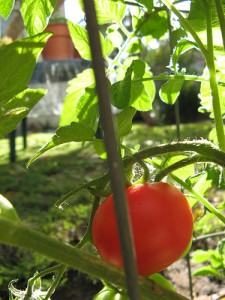
Sometimes we just wish we could have a nice patch of land to cultivate our own garden of fruits, vegetables and flowers. Adding to living in a densely populated place where space is scares, and not having enough time to care for your garden all year around, most of us end up buying our vegetables from the supermarket instead of growing it. You can actually maximize the area for your flower and your vegetable gardens together with a few steps outlined below. The key here is to work towards blending in your vegetable patch with the overall design of your garden bed, instead of making it stick out like a sore thumb.
Spring Clean Your Flower Bed
You can add space for your vegetables by maximizing the space in your flower beds. Trim any overgrown shrubs, weeds and debris. You may also want to consider planting colorful herbs and vegetables. Not only does this create an interesting focal point in your garden, it also provides you with a great return of investments. And there\’s nothing more satisfying than to know you did it yourself. Also trim back any bushes that grow out.
Fertilize the Soil
The key to a successful garden is the soil. Start by cleaning out the bed, and then enrich the soil. Fertile soil will make the vegetables grow well. It will also improve the conditions of the soil for the surrounding shrubs and flowering plant. Start by adding manure and soil conditioner to the bed (making two to three inch thick layers on top and turn it into a depth of six to eight inches. If the soil is dry, add water to it a day or two before digging. This also helps with ensuring that the compost and fertilizer work, as moisture helps the fertilizer dissolve and ensures leakage of the moisture from the compost bag to the surrounding ground. Fertilizers help by providing food to new and existing plants (if any) on the bed and help bring nitrogen, phosphorus and potassium nutrients back to the soil.
Planting Veggies with Flowers or Other Companion Plants
You will want to ensure that your vegetables and flower garden look neat and not haphazard so that it won\’t look like a tone of headache later on as they grow. Make sure you place taller shrubs and vegetables together at the back of the bed, followed by the smaller plants in front. This will also make it easier for you to manage them later as they grow out.
Do you know that by combining certain plants together, you can provide the plants with protection against disease and bugs? Certain plants are afforded such protection by other plants, and combining these plant also help you reduce the need to use pesticides and chemicals. Companion plants will also attract beneficial insects that are important for pollination and procreation, and even prey on detrimental bugs in your garden. Companion planting helps make other plants stronger and healthier, and provide insect protection to their neighbors. It must be noted though, that there are also plants that should never be grown together. Consider these combinations of vegetables when you\’re planning the layout of your garden bed:
| Type of plant | Beneficial plant | Avoid Planting: |
| Bush beans | Potatoes, cucumbers, corn, celery, strawberries, summer savory, and tansy | Onions |
| Pole beans | Corn, summer savory | Onions, beets, sunflowers |
| Cabbage, broccoli, cauliflower | potatoes, celery, dill, chamomile, sage, peppermint, rosemary, onions, and nasturtiums | strawberries, tomatoes, and pole beans |
| Carrots | peas, leaf lettuce, chives, onions, leeks, rosemary, sage, and tomatoes | Dill |
| Corn | Melons, parsley, cucumbers, peas and beans | |
| Cucumbers | Corn, bush/pole beans, lettuce, marigolds, onions, peas and radish | Herbs |
| Melons | Corn, radish, nasturtiums and sunflowers | |
| Peas | Turnips, beans, carrots, corn, cucumbers, radishes | Onion, garlic, potatoes |
| Spinach | Strawberries | |
| Squash | Corn, onions, scented marigolds, parsley and asparagus | |
| Pumpkins | Corn and sunflower | |
| Zucchini | Corn, peas and beans |
Note: Do not plant tomatoes in the same spot every year. This is to reduce incidence of bad bugs and disease attacking your tomatoes.

Image credit: Justin Taylor/Flickr.com
Once you understand what type of plant work well with each other, and work towards planting them together, you need to make sure that they thrive by watering them as accordingly and making sure that the soil is kept rich with nutrients and is fertile.
Water Your Plants
Water works by making sure the plants stay perked and helps keep them from transplant shock, as well as help dissolve the fertilizer and ensure that the roots will be able to absorb them. New plants need to be watered once a day for the first week or so. Once they are stabilized, they will need about one to two inches of water per week, although this may vary as according to the climate where you live. You can monitor the amount of water the plant is receiving by placing a rain gauge near the bed. This will help you decide how much water you will need to add to your plants.
Making It Look Good
To make your bed more \’presentable\’ with the rest of your yard, try adding some mulch to it. You may want to consider using hardwood mulch. Harwood mulch are used in landscaping, but work just as well with vegetables. There should be a thickness of three inches around the bed, with no exposed soil around the vegetables (remember to create an inch-wide gap around the plant stems to allow air circulation around the base of each plant and keep the stems from rotting).
By ensuring that your bed of garden is healthy and combining the different types of plants, you can be assured of a productive garden that will provide you with a return of your efforts.

